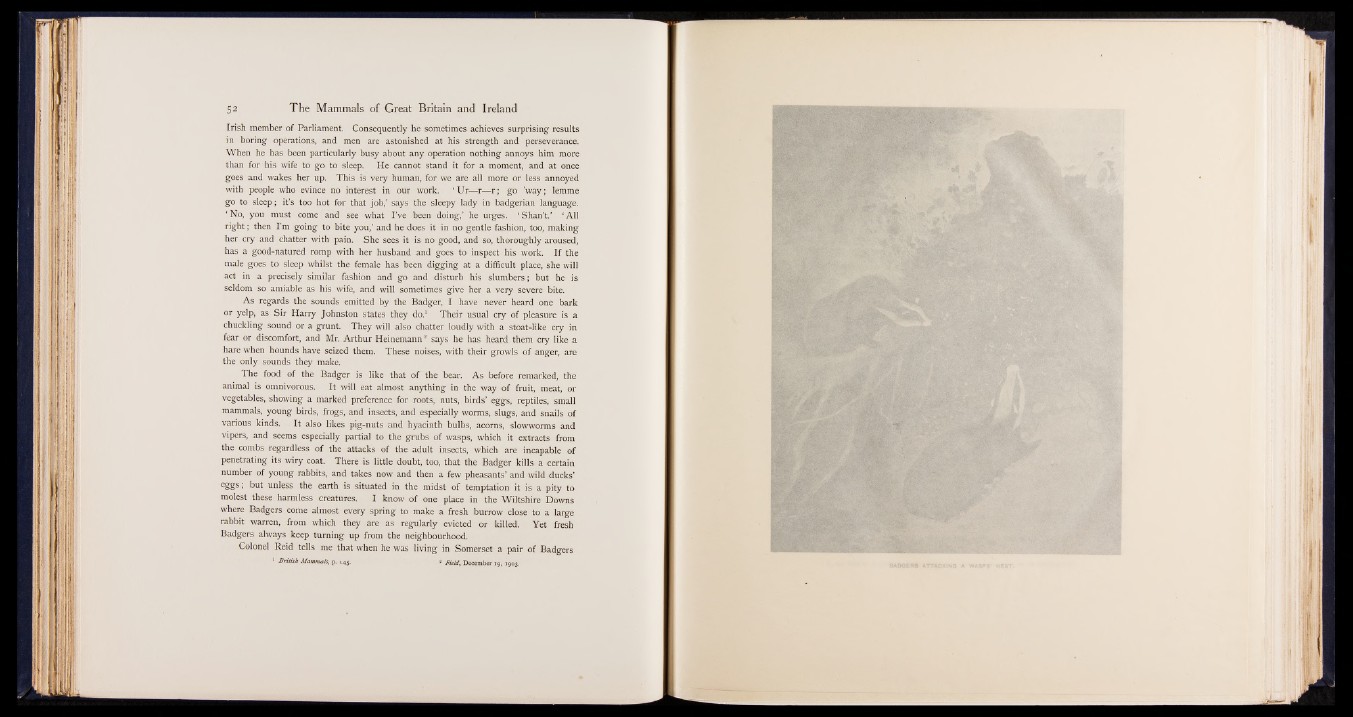
Irish member of Parliament. Consequently he sometimes achieves surprising results
in boring operations, and men are astonished at his strength and perseverance.
When he has been particularly busy about any operation nothing annoys him more
than for his wife to go to sleep. He cannot stand it for a moment, and at once
goes and wakes her up. This is very human, for we are all more or less annoyed
with people who evince no interest in our work. * Ur—r—r ; go ’w ay; lemme
go to sleep; it’s too hot for that job,’ says the sleepy lady in badgerian language.
‘ No, you must come and see what I ’ve been doing,’ he urges. ‘ Shan’t.’ ‘ All
right; then I’m going to bite you,’ and he does it in no gentle fashion, too, making
her cry and chatter with pain. She sees it is no good, and so, thoroughly aroused,
has a good-natured romp with her husband and goes to inspect his work. I f the
male goes to sleep whilst the female has been digging at a difficult place, she will
act in a precisely similar fashion and go and disturb his slumbers; but he is
seldom so amiable as his wife, and will sometimes give her a very severe bite.
As regards the sounds emitted by the Badger, I have never heard one bark
or yelp, as Sir Harry Johnston states they do.1 Their usual cry of pleasure is a
chuckling sound or a grunt. They will also chatter loudly with a stoat-like cry in
fear or discomfort, and Mr. Arthur Heinemann2 says he has heard them cry like a
hare when hounds have seized them. These noises, with their growls of anger, are
the only sounds they make.
The food of the Badger is like that of the bear. As before remarked, the
animal is omnivorous. It will eat almost anything in the way of fruit, meat, or
vegetables, showing a marked preference for roots, nuts, birds’ eggs, reptiles, small
mammals, young birds, frogs, and insects, and especially worms, slugs, and snails of
various kinds. It also likes pig-nuts and hyacinth bulbs, acorns, slowworms and
vipers, and seems especially partial to the grubs of wasps, which it extracts from
the combs regardless of the attacks of the adult insects, which are incapable of
penetrating its wiry coat. There is little doubt, too, that the Badger kills a certain
number of young rabbits, and takes now and then a few pheasants’ and wild ducks’
eg g s; but unless the earth is situated in the midst of temptation it is a pity to
molest these harmless creatures. I know of one place in the Wiltshire Downs
where Badgers come almost every spring to make a fresh burrow close to a large
rabbit warren, from which they are as regularly evicted or killed. Yet fresh
Badgers always keep turning up from the neighbourhood.
Colonel Reid tells me that when he was living in Somerset a pair of Badgers
1 British Mammals, p. 145. s Fields December 19, 1903.